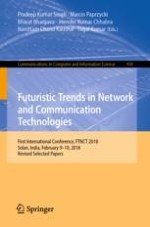2019 | Buch
Futuristic Trends in Network and Communication Technologies
First International Conference, FTNCT 2018, Solan, India, February 9–10, 2018, Revised Selected Papers
herausgegeben von: Dr. Pradeep Kumar Singh, Dr. Marcin Paprzycki, Bharat Bhargava, Jitender Kumar Chhabra, Narottam Chand Kaushal, Prof. Yugal Kumar
Verlag: Springer Singapore
Buchreihe : Communications in Computer and Information Science
